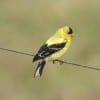 By Jim Stevenson
By Jim Stevenson
Hi Folks,
I will be sending out the dates and times (and other information) for our big Labor Day Open Houses coming up, next Monday, with another California Gallery. They will begin the Thursday before Labor Day. If you forgot to sign up for Bobwhites, please do it immediately, as an important announcement is going out tomorrow. OK, you guys have a good weekend!
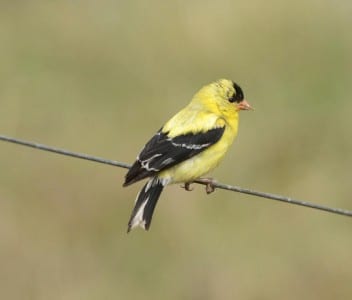
Often thought of as an eastern bird, the American Goldfinch reaches the West Coast in good numbers. Here they join the abundant Lesser Goldfinch (next), p lus the rare Lawrence’s Goldfinch as a trio of yellow. This male above is a bit worn and perhaps faded but the color still jumps out at you.
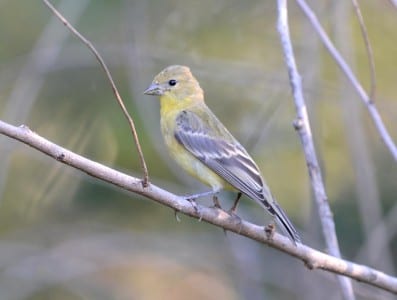
I was just thinking how some of the immature Orchard Orioles outside my window look a bit like this female Lesser Goldfinch, especially with a thinner bill. These are extremely common birds from California through the Desert Southwest, and a classic example of polymorphism. Some males have black backs and others, green. As is often the case, the females lack the var iability of the males, still having greater camouflage.
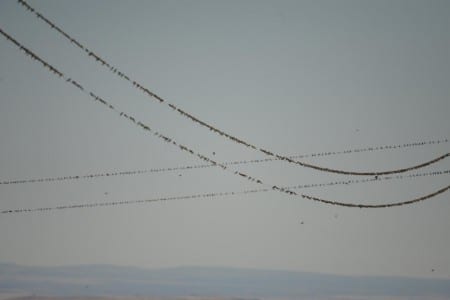
A bird far more abundant than many realize is the Bank Swallow, a smallish bird with a dark chest collar. In early fall their migration seems endless, from southern California to Alaska. This species gets its name from burrowing into banks to nest, making it difficult for predators to access their nests.
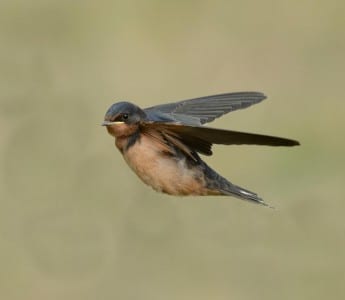
This Barn Swallow has learned to fly pretty well, as he swoops by after insects. You can tell his young age by the yellowish color at the base of the mandibles. Birds like this are in several parts of the World, accounting for about four wide-ranging species. This bird will grow a long, forked tail soon, not unlike some others like fr igatebirds, Swallowtailed Kites and Scissor-tailed Flycatchers.
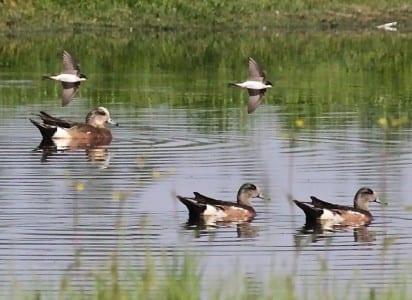
Tree Swallows, like most swallows, are wide-ranging birds that seem to have an affinity for water. In the Deep South they catch untold numbers of no-see-ums (sand gnats) off the surface of lakes, but I’m not sure what happens here in California. Birds like the swallows and wigeons pretty well ignore each other unless one eats the neighbor.
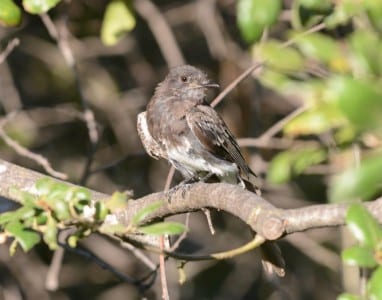
Black Phoebes most often live along watercourses in the West, often snatching up insects off the surface. This bird is typical of so many in August, racked with a severe molt and missing many feathers. In addition, it has two grown young hanging around, so it’s having to keep an eye on them while it feeds.
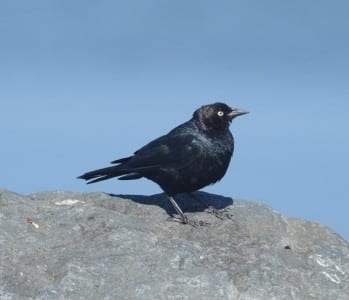
Brewer’s Blackbirds are the West’s answer to having no grackles. They are really everywhere and their white eyes have to remind us of grackles. Brewer’s are the size of redwings, without the rounded tail tip, and considerably more iridescence. There are no Rusty Blackbirds in most of its territory and Bronzed Cowbirds have red eyes, so they are very easy to pick out.
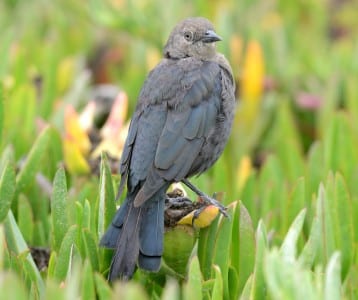
Female Brewer’s are like so many females blackbirds, great for camouflage but not much to look at. This bird is molting, as are many songbirds in ear ly August. Something was very attractive about the succulents she was sitting on, as other birds found them equally alluring. This is a good way to compare worn feathers (middle tail) to fresh ones growing out. Most birds molt in August and some in early spring.
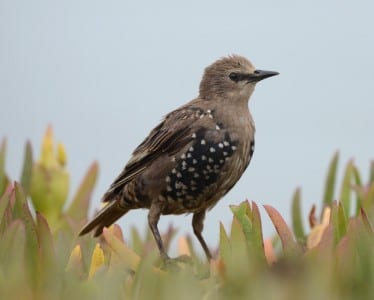
The stocky body and short tail probably told you this was a starling, although it did point out another flaw in Sibley. This is late July and they are not supposed to reach winter plumage until September. I often see mistakes in var ious guides misjudging plumage change dates, and Sibley is one of the better guides, IMHO. BTW, I really enjoyed editing his avian behavior book, and also learned a lot.
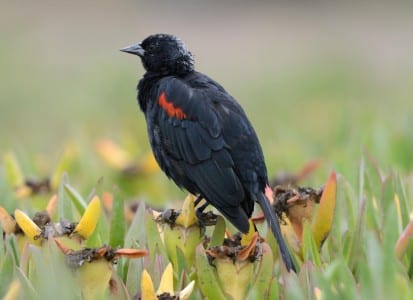
Starlings can be black birds, but this is a real blackbird, but not the one you think! This is the Tri-colored Blackbird, a species I have only seen along the central California Coast. They lack the yellow bar on the wing, replaced with white, but still show off the red. Any species, no matter how abundant, that has such a limited range, is always in danger of a disaster by disease, or whatever. BTW, there is also a Tawny-shouldered Blackbird, and others in South America are quite similar. There are also Yellow-winged Blackbirds in South America, p lus Scarlet-hooded Blackbirds, also kinda opposite from our Yellow-headed Blackbirds. The truth is, red & yellow are very similar biochemically, and may also be produced structurally. The relationship between these two colors is not well understood and needs more work.
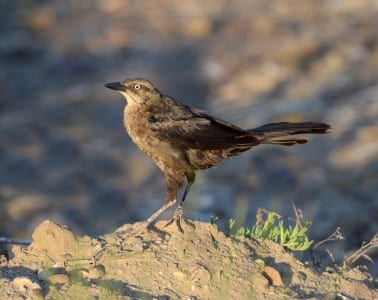
Anyone of my friends here in Texas know a female Great-tailed Grackle, although few react as this one did to being told she was the ugliest of her entire species. August isn’t the best month for shooting songbirds, especially. I suspect she’s less than two months old, looking at the shortness of the bill. This bird is pretty scarce in this area I was in, but any Californian who wants to see more grackles, I can recommend a few places in Texas.
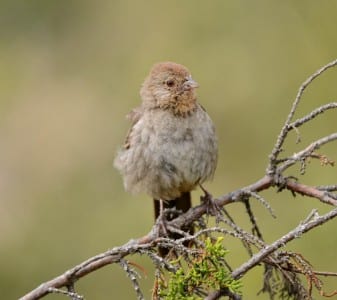
This is a California Towhee, one of the ever-increasing new species of towhees. It used to be the Brown Towhee but that was split into this one & the Canyon, just as Rufous-sided was split into Eastern and Spotted Towhees. Both of those complexes are separated geographically, so one doesn’t have to work out the subtle differences (if they just know what state they’re in).
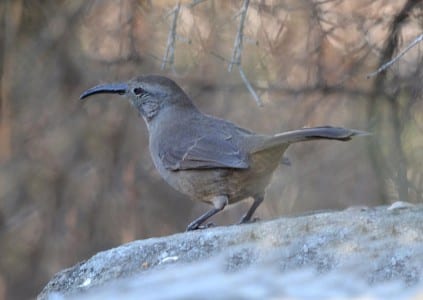
Speaking of what state, this is the California Thrasher, one of the thrashers w/ very long, decurved bills. You may also check out Curve-billed, Cr issal and Le Conte’s Thrashers in the field guide. Frankly, they make Long-billed Thrasher seem silly for nomenclature! In the Desert Southwest there are many plants with thorns and stickers. Having a very long, decurved beak enables the birds to snag food and not get their eyes poked out.
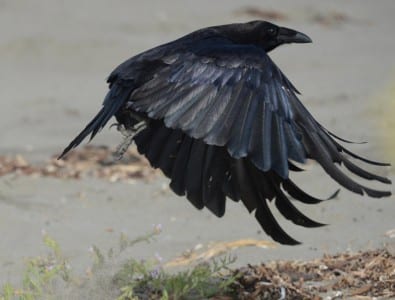
Common Ravens are the largest songbird on Earth and surely the most adaptable, living in temperatures from Arctic winter to broiling hot deserts. They were also long thought to be the most intelligent bird on Earth, though that distinction may belong to one of the parrot family. Of course, that’s about like being the gator with the largest brain.
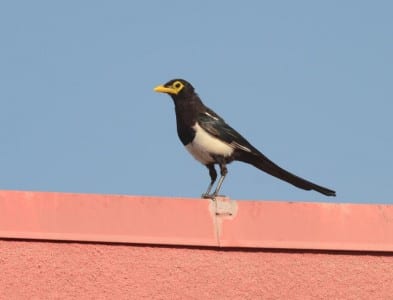
Heckle and Jekyll are both found in California, with this Yellow-billed Magpie seen only in the Central Valley. These are one of several off-beat groups of corvids (crows & jays) like nutcrackers, demonstrating the ability of that family to adapt to various lifestyles in certain localities. Most corvids are relatively nonmigratory, so finding ways to make a living 12 months/year in one location is essential.
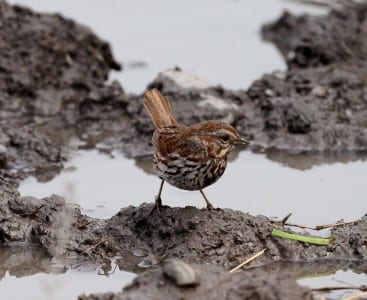
Song Sparrows are highly variable birds over much of the range, with this California race being as reddish as its cousin the Fox Sparrow of the East. They are well-known for their melodious vocalizations (note scientific name) and often nest quite close to dwellings of our species. The large spot on the chest is regarded as a good field mark but in truth, it is found on quite a few sparrows! BTW, this bird is quite a bit redder anteriorly than most of its race (Pacific Coast), at least according to Sibley.
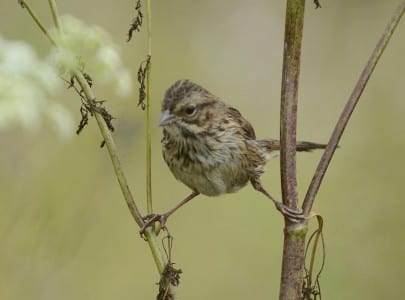
I am assuming this is a Lincoln’s Sparrow, although it looks almost too ratty to tell. The telltale buffy collar may be obscured by a puddle bath, and the facial markings and large legs are good for this species. Many sparrows have ranges which extend all the way across the Country, as seed-eaters always seem to have something available. In Texas, this is a very common – though slightly withdrawn – winter resident.
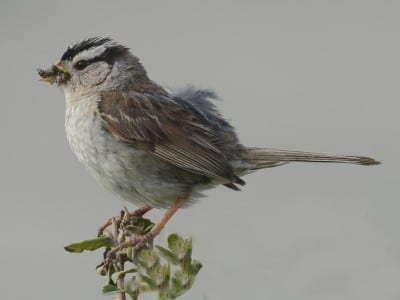
This White-crowned Sparrow is taking food to its young, but like most adults with food it won’t go to the nest with people around.That works well for photography; just be quick about it! This is an extremely wide-ranging species, most easily seen in the South in late fall. They are superficially similar to the forest-loving White-throated Sparrow of the East, and the likely ancestor of the Golden-crowned Sparrow of the Pacific Coast. It is sad they are so scarce in the Deep South.
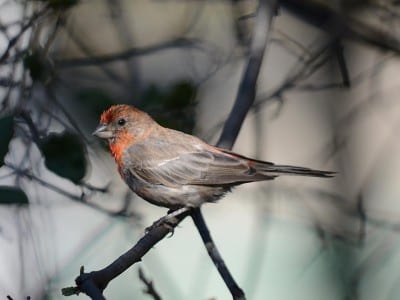
House Finches are one of several reddish seed-eaters our Continent hosts, with these seen at bird feeders over much of the Lower 48. There’s a surprising amount of variation with males and the amount of red on their anteriors, p lus House Finches have less red than the other two close relatives. These turn up occasionally at feeders in the Houston/Galveston area, curiously being regular at the parking lot on Pelican Island.
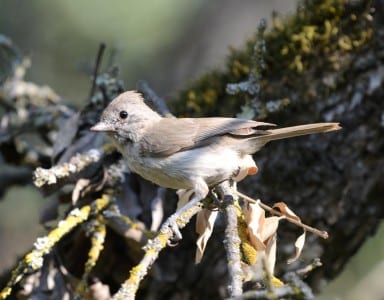
Like the two (four) towhee species, the Plain Titmouse has also been divided into a pair of species, largely based on their range. This California bird is the Oak Titmouse, split off from the Juniper Titmouse geographically. Of course, birders are delighted when these splits occur; it means life birds, even though most couldn’t begin to tell the difference in the two. The AOU went 2 for 3 with the names, as they *are* a “plain” bird, this titmouse *is* in an oak tree, but since I saw the other species when I did, it should be a Julyaper Titmouse, rather than Juniper. Scary to think I teach birding classes…
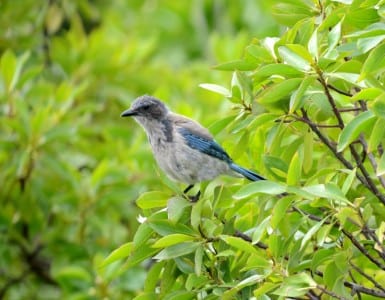
This is an immature Western Scrub-jay, with a huge range compared to the scarce Florida Scrub-jay (the only true endemic of the Sunshine State). These are not deep forest birds, but rather make a living around bushes and modest clumps of trees. Off California’s coast on the island of Santa Cruz is the Island Scrub-jay, one of America’s most local species
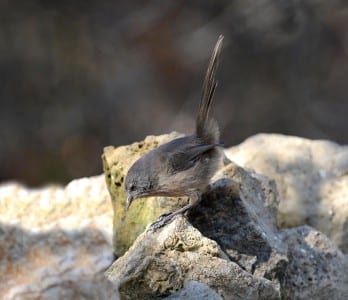
Another truly remarkable West Coast bird is the Wrentit, one of the most varied vocalists in the Country. Its relationship to other species is not clear, and like many birds, the odd English name has no real reference to relationship – just appearance. It is interesting to me how many unbelievably vocal birds there are around the World, and how most of them are plain as white bread and dang hard to see!

 Posted in
Posted in 
























For all you bmw enthusiast people should come on over at what we have for some of the best ladies wear online for Nissan .